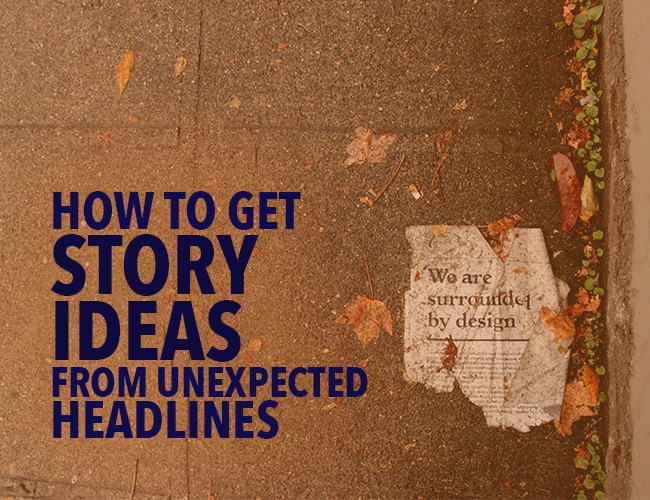No, this is not a how-to for creating fake news. It’s a prompt that opens a never-ending well of ideas for any fiction writer. I’m talking about how to get story ideas from headlines in the news. Try it out today and see what happens!

How to Get Story Ideas From Headlines: 4 Steps
A few years ago, I read a startling headline in a back section of the Sunday newspaper. It said “Man Likely Padlocked Himself in Bag Found in Bathtub.” I blinked twice, sure I had misread something.
Even after I read the article, I still couldn’t believe it. I was grieved for his family and friends, but I couldn’t help but see the possibilities for inspiring fiction. I wondered how it could even be done? As a claustrophobic, I wondered, why?
This situation and article were surely stranger than fiction, but it prompted so many questions. Turns out questions are at the heart of great fiction, and you can use headlines to develop ideas all day long. Here’s how to get story ideas from the strangest news headlines.
1. Find Headlines
The first step in how to get story ideas from headlines? Look for headlines.
Find a newspaper and scan through the headlines. You don’t have to read entire articles to find inspiration from their titles. I have found that for fiction, I prefer to search anywhere but the front page. I usually know too much already about the events that make the front page, and I’m after something that prompts new questions, ideas, and worlds.
Look until you find a headline that immediately floods your mind with questions. Headlines that prompt a “Why” and “What if . . .” response are best. Some from today’s headlines:
Workers Unearth Mystery Buried in SC School
Family Car Parked at Charlotte Douglas [Airport] Was Filled with Ants. They Want an Explanation.
Parents Brawl During Youth Football Handshake Line
I found all of these headlines in about five minutes by looking up regional or state newspapers and clicking on the “local” tab.
2. Ask Questions
Once I find a few headlines that scream for exploration, I make a list of the questions one prompts. Again, I spend no time reading the article; I’m only mining the headline for ideas. Here are some questions I wrote down for my headlines above.
Workers Unearth Mystery Buried in SC School: The wording of this headline fascinates me. Buried IN school? Like inside a wall? What were they digging up? Were children present? What is the mystery? Who will solve it? Is it valuable and might need protection? Is it linked to an old legend or cold case?
My only question for the ant-filled car was, Did you fumigate it and what did you use? (I can’t seem to get rid of some ants here, so I might be a little caught up in my own problems to fully explore this one.)
For the parent brawl, I want to know about the relationships. Who started it? Was it between parents on the same team? Was it a mixed group of men and women? Who broke it up? How much irony can you pack in one scene where adults fight while kids shake hands?
3. Flip the Genre
Once you have a good set of questions for several headlines, choose the one that is most compelling. Some of my example headlines lend themselves easily to certain genres.
The “mystery unearthed” might well be mystery, suspense, or horror. The ants could be science fiction or magical realism (Did anyone else think of Gabriel Garcia Marquez’s ants from One Hundred Years of Solitude when you read that headline?). The parent brawl might be realistic fiction or the beginning of a crime fiction piece.
Identifying genre can be a short-cut to creating fresh ideas, simply because you can flip or twist what is expected.
What if the mystery unearthed isn’t suspense but a romance? What if the car full of ants becomes a witty children’s book instead of the horror story it appears to be? Maybe the parent brawl isn’t the beginning of a true crime tale but the opening to a space opera story where irony beams people into an antigravitational state. (I think I might have gone too far on that last one — I’m out of my depth).
4. Apply Story Principles and Write
Once you have those questions and a possible genre, identify your main character and give them a strong goal. Throw things in the way of getting what they want, and force them to act.
The story might go somewhere completely unexpected, but that’s the fun! I’ve had students write two to three stories in different genres using the same headline to show them how inspiration can go anywhere they want.
Stranger Than Fiction
Oh, and the guy in the duffle bag? Turns out he was a spy, but they reported he did indeed lock himself in the bag. Hmmm . . . I have a few questions.
(Yes, I apologize for my morbid insensitivity at reading about a man’s death and trying to spin fiction from it. I’m not fit for polite company. May he rest in peace.)
Real life might be stranger than fiction, but it certainly doesn’t disappoint when you are looking for story ideas.
Have you ever read any headlines that inspired a story? Share in the comments.
PRACTICE
Set a timer for fifteen minutes and generate some story ideas today using any headlines you can find. List your top three headlines and the questions or ideas they prompted.
Share your headlines and questions in the comments. And if you share, be sure to leave feedback for your fellow writers! What questions do the headlines they found make you ask?
The post How to Get Story Ideas From Unexpected Headlines appeared first on The Write Practice.
from The Write Practice https://ift.tt/2PdEpCJ
No comments:
Post a Comment